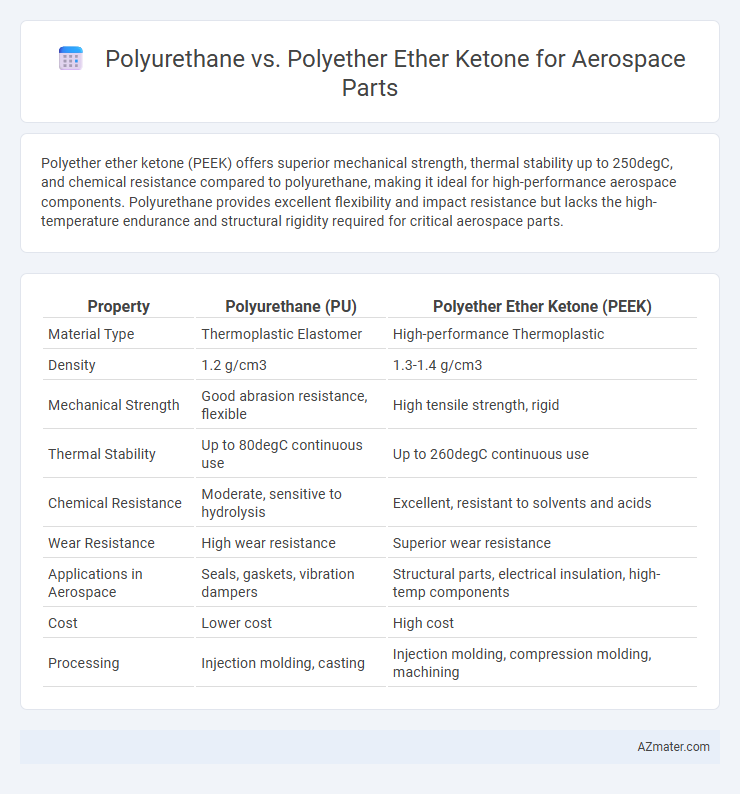Polyether ether ketone (PEEK) offers superior mechanical strength, thermal stability up to 250degC, and chemical resistance compared to polyurethane, making it ideal for high-performance aerospace components. Polyurethane provides excellent flexibility and impact resistance but lacks the high-temperature endurance and structural rigidity required for critical aerospace parts.
Table of Comparison
| Property | Polyurethane (PU) | Polyether Ether Ketone (PEEK) |
|---|---|---|
| Material Type | Thermoplastic Elastomer | High-performance Thermoplastic |
| Density | 1.2 g/cm3 | 1.3-1.4 g/cm3 |
| Mechanical Strength | Good abrasion resistance, flexible | High tensile strength, rigid |
| Thermal Stability | Up to 80degC continuous use | Up to 260degC continuous use |
| Chemical Resistance | Moderate, sensitive to hydrolysis | Excellent, resistant to solvents and acids |
| Wear Resistance | High wear resistance | Superior wear resistance |
| Applications in Aerospace | Seals, gaskets, vibration dampers | Structural parts, electrical insulation, high-temp components |
| Cost | Lower cost | High cost |
| Processing | Injection molding, casting | Injection molding, compression molding, machining |
Introduction to Aerospace Material Selection
Polyether ether ketone (PEEK) offers superior thermal stability, mechanical strength, and chemical resistance compared to polyurethane, making it highly suitable for aerospace components subjected to extreme environmental conditions. Polyurethane provides excellent flexibility, impact resistance, and cost-effectiveness but falls short in high-temperature applications typical in aerospace settings. Selecting aerospace materials requires balancing performance parameters such as weight, durability, and thermal endurance, where PEEK often outperforms polyurethane for critical load-bearing and high-stress parts.
Overview of Polyurethane in Aerospace Applications
Polyurethane in aerospace applications is valued for its excellent flexibility, abrasion resistance, and lightweight properties, making it ideal for seals, gaskets, and vibration dampening components. Its ability to withstand varying temperatures and maintain performance under mechanical stress contributes to enhanced durability in aircraft interiors and structural parts. Compared to polyether ether ketone (PEEK), polyurethane offers cost-effective versatility, though it may have lower thermal stability and chemical resistance.
Understanding Polyether Ether Ketone (PEEK) in Aerospace
Polyether Ether Ketone (PEEK) offers exceptional mechanical strength, chemical resistance, and thermal stability, making it ideal for aerospace parts exposed to extreme environments. Compared to polyurethane, PEEK maintains structural integrity at elevated temperatures up to 250degC and exhibits superior resistance to radiation and aggressive chemicals. These properties enable PEEK to enhance the reliability and lifespan of critical aerospace components such as bearings, seals, and structural supports.
Mechanical Properties Comparison: Polyurethane vs PEEK
Polyurethane exhibits high elasticity and impact resistance, making it suitable for cushioning and vibration-damping aerospace components. Polyether ether ketone (PEEK) offers superior tensile strength, thermal stability up to 250degC, and excellent chemical resistance, which are critical for structural aerospace parts exposed to extreme conditions. While polyurethane is favored for flexible applications, PEEK's mechanical properties make it ideal for load-bearing parts requiring durability and rigidity in aerospace environments.
Thermal Stability and Performance under Extreme Conditions
Polyether ether ketone (PEEK) exhibits superior thermal stability compared to polyurethane, maintaining its mechanical integrity at temperatures up to 250degC, which is critical for aerospace components exposed to extreme heat. PEEK also offers exceptional chemical resistance and dimensional stability in harsh environments, outperforming polyurethane in scenarios involving thermal cycling and aggressive chemicals. Polyurethane, while flexible and impact-resistant, degrades more rapidly under high-temperature conditions, limiting its use in aerospace parts requiring long-term durability and performance under extreme stress.
Chemical Resistance: Suitability for Aerospace Environments
Polyether ether ketone (PEEK) exhibits exceptional chemical resistance, maintaining structural integrity against acids, solvents, and harsh aerospace fluids at elevated temperatures. In contrast, polyurethane, while flexible and impact-resistant, is more susceptible to degradation from prolonged exposure to fuels, hydraulic fluids, and UV radiation commonly encountered in aerospace environments. The superior chemical inertness and thermal stability of PEEK make it the preferred choice for critical aerospace components requiring long-term durability and reliability in aggressive chemical conditions.
Weight Considerations and Impact on Aircraft Efficiency
Polyether ether ketone (PEEK) offers a high strength-to-weight ratio that significantly reduces component weight compared to polyurethane, enhancing overall aerospace part efficiency. The lower density of PEEK contributes to decreased aircraft weight, improving fuel efficiency and payload capacity. Utilizing lightweight yet durable PEEK materials directly supports reduced emissions and operational costs in aerospace applications.
Manufacturing and Processing Differences
Polyurethane offers versatile manufacturing methods like casting, injection molding, and extrusion, enabling rapid prototyping and complex geometries ideal for aerospace applications. Polyether ether ketone (PEEK) requires high-temperature processing techniques such as compression molding and CNC machining due to its high melting point and thermal stability, making it suitable for high-performance aerospace components. The choice between polyurethane and PEEK hinges on processing equipment capabilities, thermal requirements, and desired mechanical properties in aerospace part production.
Cost Analysis and Lifecycle Value
Polyether ether ketone (PEEK) exhibits significantly higher upfront costs compared to polyurethane, driven by its superior thermal stability and mechanical properties essential for aerospace applications. Despite the initial investment, PEEK offers enhanced lifecycle value through exceptional chemical resistance, reduced maintenance, and longer service intervals, resulting in lower total cost of ownership over time. Polyurethane, while cost-effective initially, may incur higher replacement and maintenance expenses due to its lower durability and susceptibility to environmental degradation in demanding aerospace environments.
Choosing the Right Material for Specific Aerospace Parts
Polyether ether ketone (PEEK) offers superior thermal stability, chemical resistance, and mechanical strength, making it ideal for high-performance aerospace components such as turbine blades and structural parts. Polyurethane provides excellent flexibility, impact resistance, and vibration damping, making it suitable for seals, gaskets, and cushioning applications within aircraft interiors. Selecting the right material depends on factors like operating temperature, load requirements, and exposure to chemicals, ensuring optimal performance and longevity in aerospace environments.

Infographic: Polyurethane vs Polyether ether ketone for Aerospace part
 azmater.com
azmater.com